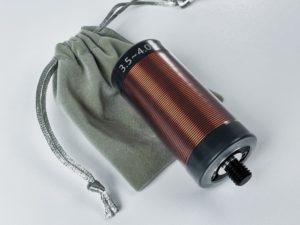- What is the maximum power to drive with MC-750 in digital modes, for instance FT8?
In the product description we stated 100 watts PEP which means you should use maximum 50 watts for digital modes. In fact, we’ve tested in the field with FT-8 100 watts and SSB 200 watts without any issues. (Without the 7MHz loading coil). However it’s not guaranteed – We would still recommend you to use the antenna within the power range from our description(100-watt PEP).
- When should I use the 7MHz coil and when shouldn’t?
When you want to operate on 7MHz the coil will be used, otherwise it shouldn’t be used
- Why I can’t find 50MHz and 10MHz markings on the telescoping whip?
The 7MHz coil should be used for 7MHz and 10MHz. Frequencies above 14MHz do not require the use of the coil. For more detailed information, please refer to the user manual.
- Can you please tell me what the collapsed length of the telescoping whip is for your antenna model MC-750?
The extended length of the whip is 5.6m and the collapsed length around 53.5cm.
- Can the spike on the MC-750 be swapped out for another mount, like a tripod or clamp?
Yes – The spike and the base(transformer) uses M10 and can be separated. We have also sourced an adaptor to support the antenna. You can find it here
- What kind of threads are used to connect the antenna to the base?
The base and the black extension tube uses M12, while the other parts uses M10.The reason there’s a difference in the design was to prevent users from putting the 7MHz coil directly into the base by mistake, instead of putting it on top of the extension tube.
- If I want to operate 80m band, Could I install the 80m coil and 40 coil together for MC-750 ANT? Can installing both together tune to higher frequency/ bands?
For 80m band, only install the 80m coil. It’s enough. Regarding the installation of these two coils together for MC-750, to be honest, we haven’t tried it yet, but everyone can give it a try.
- What is the difference between MC-750 and JPC-12?
These two products are quite similar in terms of performance. However, there are a few key design differences that distinguish them:
For instance, the MC-750 is full size antenna above 14Mhz and it features banana plugs for connecting radials, while the JPC-12 uses coils for all bands and utilizes a ground net for connections. This means the connection types vary, but the overall performance remains consistent between the two.
Also, The MC-750 has more comprehensive documentation, and you will find numerous positive reviews and instructional videos available online. This could make it easier to understand and use the product effectively.
The JPC-12, however, has an easier carry bag over MC-750 as the size is smaller.
Despite these differences in design and support materials, both products deliver comparable performance. Your choice between the two may ultimately come down to personal preference or specific use cases.
- What is the length of the MC-750 whip?
The whip has 14 sections, extends to 5.6 meters, and retracts to 53.5 cm.
Yes, the MC-750 can generally withstand different weather conditions, such as rain, snow, and wind. However, prolonged outdoor exposure may reduce the durability of the extendable rods, so monitoring their condition is advised. Additionally, weather changes may slightly affect performance parameters, so it’s a good idea to keep an eye on the standing wave ratio (SWR) to ensure optimal operation.
- What is the quality of the MC-750 whip?
Regarding the product quality, each section of every whip is carefully printed with measurements and undergoes stretching checks. Very low probability of quality issues. Therefore, the possibility of a quality issue is very low. Additionally, we conduct a final inspection before shipment to ensure everything is in proper condition.
- How to use MC-750 whip correctly and precautions?
Here are the correct usage instructions and precautions for the whip:
- The whips should first be attached to the antenna before extending them. After installing the antenna, try extending the whips again.
- When extending the whip, start extending the thinnest section first, and gradually move on to the thicker sections, finishing with the thickest section.
- When collapsing the whip, start with the thickest section, then move to the thinner sections, and finally collapse the thinnest section.
- Note: The whip is the most brittle part of the entire antenna system and needs to be properly protected.

















 Subscribe to Chelegance channel
Subscribe to Chelegance channel




